PROCESS | root domestication¶
ROOT STRUCTURES RESEARCH | Creating the first samples¶
I use Miro board to plan and organize future tasks and subjects for monitoring, planning and developing my project. MIRO BOARD
OBJECTS OF OBSERVATION | Grass, legumes, microgreens¶
My first step was to map out enough resources and all the tools and things I would need to make materials from roots. I was researching where to buy seeds and soil (or other growing mediums), and how to provide optimal growing conditions for my first trial. My current focus is on growing plants indoors. I decided to focus on various seeds, including grass, legumes, and those used for microgreens. I also educated myself on how to work with seeds.
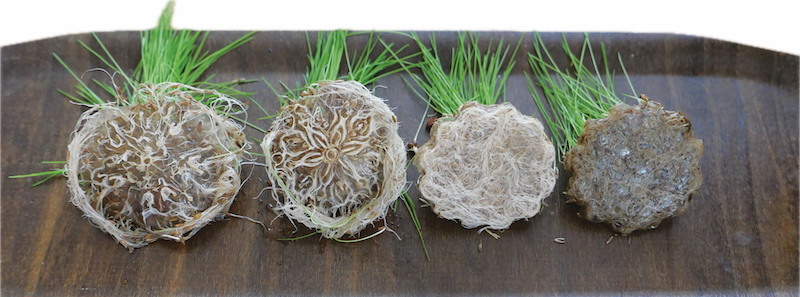
GERMINATING SEEDS¶
Germinating seeds is the process by which a seed develops into a new plant. It involves the activation of the seed's metabolic processes, leading to the emergence of a young shoot or root.
- Soaking can accelerate germination and increase the proportion of seeds that successfully germinate.

In the table below I mention the seeds I used for the experiments. I sort the subsequent experiments according to the seed chosen and mention the different types of substrate.
| TYPE OF PLANT | GERMINATION PROCESS | ROOT TYPE | Seed source |
|---|---|---|---|
| Brown lentils | 24-48 hours to germinate in water - soaking in water before placing in growing media | taproot | supermarket - intended for cooking |
| Alfalfa | germinate in 2 to 6 days - soaking in water before placing in growing media | tap root | Healthy food store - intended for germination |
| Grass Seed for Dry Areas - Bermuda grass | I didn't pre-soak them | fibrous roots | garden centre - taught to planting |
| Cranberry beans | 24-48 hours to germinate in water - soaking in water before placing in growing media | taproot | supermarket - intended for cooking |
| Black beans | 48 hours to germinate in water - soaking in water before placing in growing media | taproot | supermarket - intended for cooking |
| Radish | germinate in 2 days - soaking in water before placing in growing media | taproot | Healthy food store - intended for germination |
TYPE OF PLANT | Grass Seed for Dry Areas - Bermuda grass¶
GRASS GROWTH IN COCO COIR¶
| SUBSTRATE | CONSISTENCY | IMPACT ON THE PATTERN | IMPORTANT INSIGHTS |
|---|---|---|---|
| COCO COIR | larger particles | the fine pattern has not grown in completely | It seems to me that in places where the grass was struggling with larger pieces there was no continuous regrowth. |
Description of the process¶
I used a grid silicone mold (originally for waffles) for the experiment. Its thickness was approximately 1.5 centimetres.
Place of growth¶
Placed on the window sill - natural light.
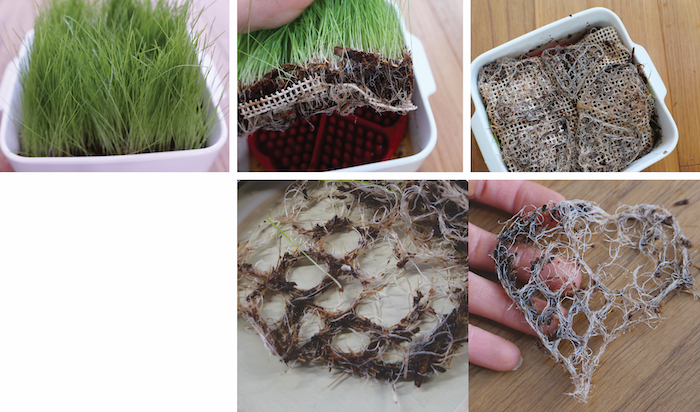
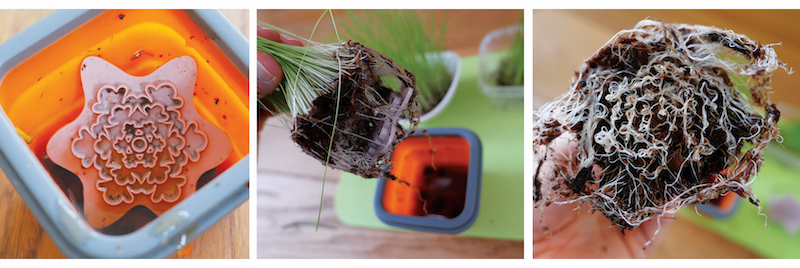
- As it grows through the mesh - the roots penetrate and then gradually decompose at the bottom of the container that holds the water.
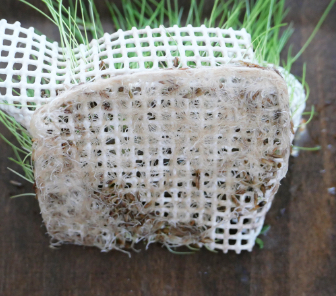
GRASS GROWTH IN AGAR AGAR¶
| SUBSTRATE | CONSISTENCY | IMPACT ON THE PATTERN | IMPORTANT INSIGHTS |
|---|---|---|---|
| AGAR AGAR | jelly-like substance made from red algae, it is more fragile after drying | fine patterns have grown very well and uniformly | better results than coco coir - Agar agar gel seems as a practical medium for plants. It is translucent and the plant decides how much moisture to absorb. |
Description of the process¶
I used two 6x6 cm fine-pattern form with a pattern thickness of 3 mm. And silicone mold with with a patterned edge to see how the grass will grow in a circumscribed flat shape. Prior to planting, the growth medium (agar agar gel) had to be prepared and cooled properly after boiling. I used a relatively small concentration in water. This made it somewhat fragile and it had to be handled carefully after casting.
Place of growth¶
Placed on the window sill - natural light.
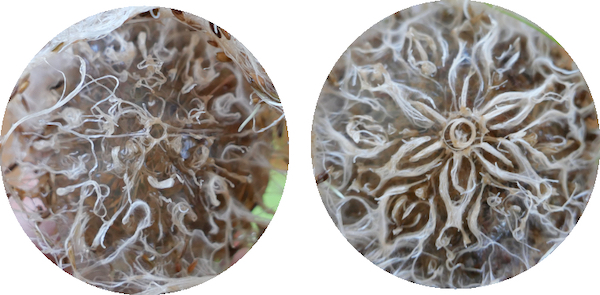
Growth medium preparation
∙ 4g agar
∙ 1l water
∙ Molds
∙ Pots and stovetop
∙ Mixing tools (spatula, cooking spoon, fork)
∙ Spatula or squeegee
∙ digital weighing scale
∙ Measure the ingredients.
∙ Add all in a pot and mix well
∙ Heat the mixture until it starts bubbling while stirring constantly.
∙ Pour mixture into a mold (let it cool for a bit before if the mold is not heat resistant)
∙ Let the material cooldown to jelly consistency
The first two photos show the root growth in a 6x6 cm fine-pattern form with a pattern thickness of 3 mm.


- Experiment with the appearance of the form without a more radical structure.
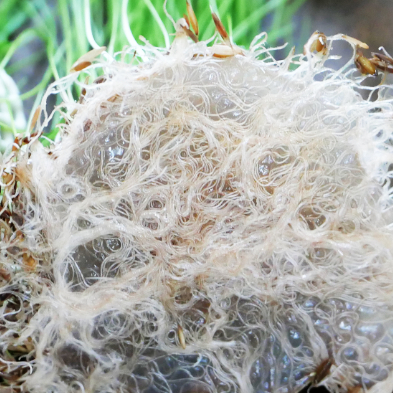

- Experiment with very low agar concentration (2g per litre of water) and liner pattern. The low concentration caused very slow drying and it was difficult to separate the roots from the mould when harvesting. They literally floated in the medium and their structure was disturbed.

- Interaction of grass in agar and mold with depressions. I placed a flat sheet of agar on top of the silicone mold, so the roots grew through and created a spatial structure outside the agar gel.

GRASS GROWTH IN SUBSTRATE - SOIL¶
| SUBSTRATE | CONSISTENCY | IMPACT ON THE PATTERN | IMPORTANT INSIGHTS |
|---|---|---|---|
| Vegetable compost, wood fiber, composted pine bark, earthworm humus. | Apparent Dry Density: 0,380 kg/l Organic matter on dry matter: 66% s.m.s. pH: 7,45 | poor growth pattern, the roots grow a lot through the substrate | The substrate retains moisture well and is also a source of nutrients that have a good effect on the growth rate. |
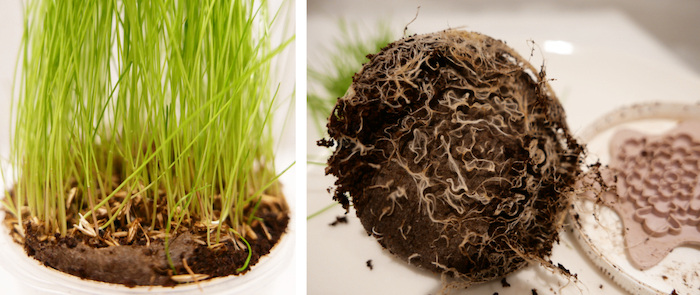
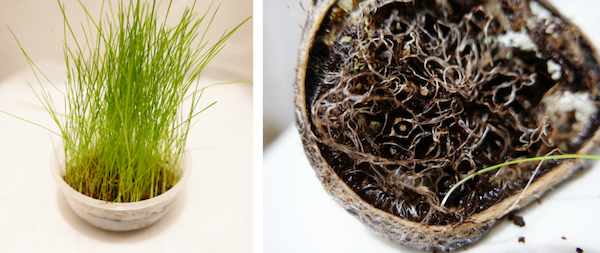
TYPE OF PLANT | BLACK BEANS¶
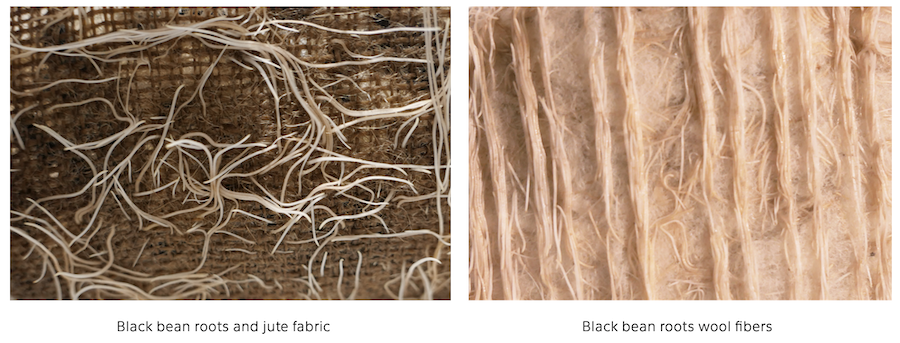
ROOT STRUCTURES | Brief summary¶
I took a closer look at the beans' root structures, paying particular attention to how they interacted with other media. The main characteristic I noticed was that the roots didn't intertwine too much with each other, but instead were quite strong and long. After conducting several experiments, I found that the microgreens did not hold together well, while the grass had some success.
